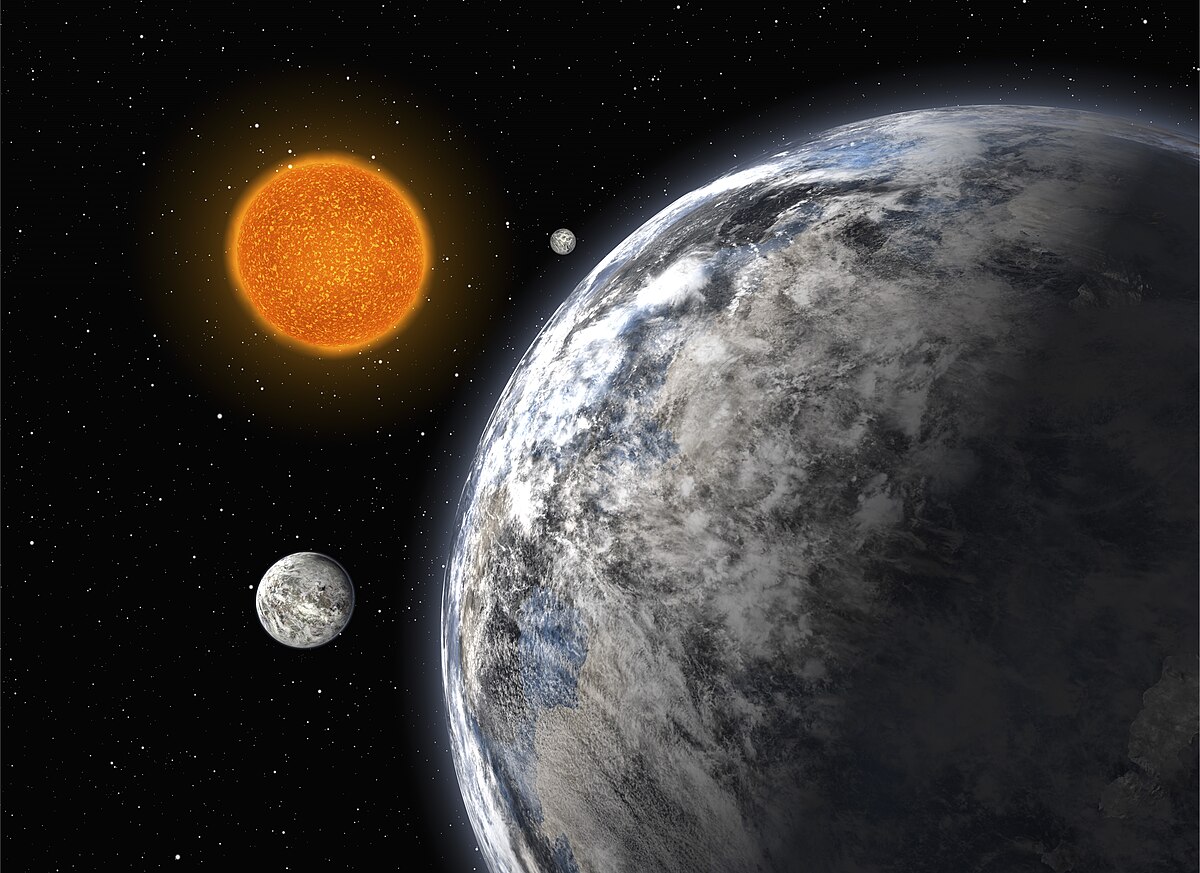| Discovery | |
|---|---|
| Discovered by | Mayor et al. |
| Discovery site | La Silla Observatory, Chile |
| Discovery date | 18 June 2008 |
| Detection method | radial velocity, using HARPS |
| Orbital characteristics | |
| Semi-major axis | 0.0468 −0.0445 AU |
| Eccentricity | 0.20 −0.04 |
| Orbital period (sidereal) | 4.3115 ± 0.0006 d |
| Semi-amplitude | 1.94 −1.67 |
| Star | HD 40307 |
HD 40307 b is an extrasolar planet orbiting the star HD 40307, located 42 light-years away in the direction of the southern constellation Pictor. The planet was discovered by the radial velocity method, using the European Southern Observatory's HARPS apparatus, in June 2008. It is the second smallest of the planets orbiting the star, after HD 40307 e. The planet is of interest as this star has relatively low metallicity, supporting a hypothesis that different metallicities in protostars determine what kind of planets they will form.
Discovery
As with many other extrasolar planets, HD 40307 b was discovered by measuring variations in the radial velocity of the star it orbits. These measurements were made by the High Accuracy Radial Velocity Planet Searcher (HARPS) spectrograph at the Chile-based La Silla Observatory. The discovery was announced at the astrophysics conference that took place in Nantes, France between 16 and 18 June 2008. HD 40307 b was one of three found here at the time.
Orbit and mass
HD 40307 b is the second lightest planet discovered in the system, with at least 4.2 times the mass of the Earth. The planet orbits the star HD 40307 every 4.3 Earth days, corresponding of its location at approximately 0.047 astronomical units from the star. The eccentricity of the planet's orbit was found to not differ significantly from zero, meaning that there is insufficient data to distinguish the orbit from an entirely circular one.
The star around which HD 40307 b orbits has a low metallicity, compared to other planet-bearing stars. This supports a hypothesis concerning the possibility that the metallicity of stars during their births may determine whether a protostar's accretion disk forms gas giants or terrestrial planets.
The Arizonan astronomer Rory Barnes's mathematical model, in 2009, found that "Planet b's orbit must be more than 15◦ from face-on"; however it cannot be much more.
Characteristics

 HD 40307 b. Artist impression
HD 40307 b. Artist impression
HD 40307 b does not transit and has not been imaged. More specific characteristics, such as its radius, composition, and possible surface temperature cannot be determined.
With a lower mass bound of 4.2 times the mass of the Earth, HD 40307 b is presumably too small to be a jovian planet. This concept was challenged in a 2009 study, which stated that if HD 40307 b is terrestrial, the planet would be highly unstable and would be affected by tidal heating in a manner greater than Io, a volcanic satellite of planet Jupiter; restrictions that seem to bind terrestrial planets, however, do not restrict ice giant planets like Neptune or Uranus.
As strong tidal forces often result in the destruction of larger natural satellites in planets orbiting close to a star, it is unlikely that HD 40307 b hosts any satellites.
HD 40307 b, c, and d are presumed to have migrated into their present orbits.
Trivia
The planet was named "Good Planet" in the Xkcd strip "Exoplanet Names" in August, 2013.
See also
References
- ^ Tuomi, Mikko; Anglada-Escudé, Guillem; Gerlach, Enrico; Jones, Hugh R. A.; Reiners, Ansgar; Rivera, Eugenio J.; Vogt, Steven S.; Butler, R. Paul (17 December 2012). "Habitable-zone super-Earth candidate in a six-planet system around the K2.5V star HD 40307". Astronomy & Astrophysics. 549: A48. arXiv:1211.1617. Bibcode:2013A&A...549A..48T. doi:10.1051/0004-6361/201220268. S2CID 7424216.
- ^ M. Mayor; S. Udry; C. Lovis; F. Pepe; D. Queloz; W. Benz; et al. (2009). "The HARPS search for southern extra-solar planets. XIII. A planetary system with 3 Super-Earths (4.2, 6.9, & 9.2 Earth masses)". Astronomy and Astrophysics. 493 (2): 639–644. arXiv:0806.4587. Bibcode:2009A&A...493..639M. doi:10.1051/0004-6361:200810451. S2CID 116365802.
- Mayor; et al. (2008-06-16). "Trio of 'super-Earths' discovered". BBC News. Retrieved 2008-06-16.
- ^ Bryner, Jeanna (June 16, 2008). "3 super-Earths found around one star". NBC News. Archived from the original on December 13, 2013. Retrieved 2008-10-30.
- "Notes for Planet HD 40307 b". Extrasolar Planets Encyclopaedia. 2008. Retrieved 2008-10-30.
- ^ Barnes, R.; Jackson, B.; Raymond, S.; West, A.; Greenberg, R. (2009). "The HD 40307 Planetary System: Super-Earths or Mini-Neptunes?". The Astrophysical Journal. 695 (2): 1006–1011. arXiv:0901.1698. Bibcode:2009ApJ...695.1006B. doi:10.1088/0004-637X/695/2/1006. S2CID 18849636.
- Characterizing Extrasolar Planets, Timothy M. Brown, chapter 3, Extrasolar Planets: XVI Canary Islands Winter School of Astrophysics, edited by Hans Deeg, Juan Antonio Belmonte, and Antonio Aparicio, Cambridge, UK: Cambridge University Press, 2007, ISBN 0-521-86808-4.
- Barnes, J.; O'Brien, D. (2002). "Stability of Satellites around Close-in Extrasolar Giant Planets". The Astrophysical Journal. 575 (2): 1087–1093. arXiv:astro-ph/0205035. Bibcode:2002ApJ...575.1087B. doi:10.1086/341477. S2CID 14508244.
- "Exoplanet Names".
External links
- "HD 40307". Exoplanets. Archived from the original on 2016-11-30. Retrieved 2008-11-09.
- "HD 40307 b". Exoplanets. Archived from the original on 2012-03-04. Retrieved 2008-11-09.
| HD 40307 system | |
|---|---|
| Stars | |
| Planets | |